Obesity Control: Grant Proposal for South Australia, Northern Adelaide
VerifiedAdded on 2023/06/03
|26
|5957
|61
Report
AI Summary
This report presents a grant proposal for an obesity prevention and control intervention in Northern Adelaide, South Australia, addressing the rising rates of obesity and related health complications. The proposal includes a needs analysis, aims and objectives focused on awareness creation, promoting physical activity, ensuring access to healthy food options, and fostering health behavior and attitude changes. The action plan incorporates a whole-of-community, multi-sectorial, and multi-component approach. The anticipated outcome is behavioral change leading to a healthier lifestyle, with an evaluation plan to assess the intervention's effectiveness. This document is useful for students looking for similar solved assignments and past papers; these are available on Desklib.
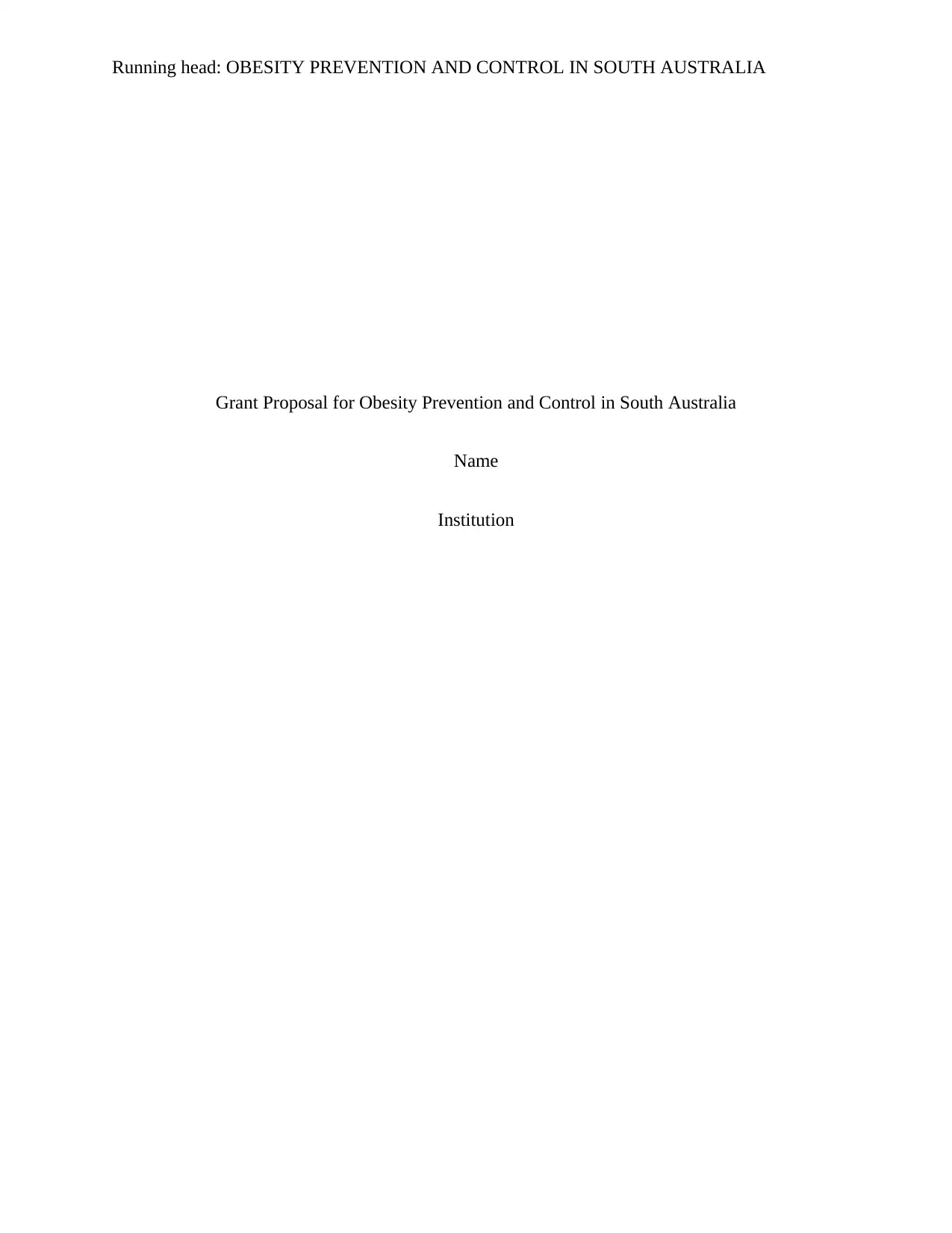
Running head: OBESITY PREVENTION AND CONTROL IN SOUTH AUSTRALIA
Grant Proposal for Obesity Prevention and Control in South Australia
Name
Institution
Grant Proposal for Obesity Prevention and Control in South Australia
Name
Institution
Paraphrase This Document
Need a fresh take? Get an instant paraphrase of this document with our AI Paraphraser
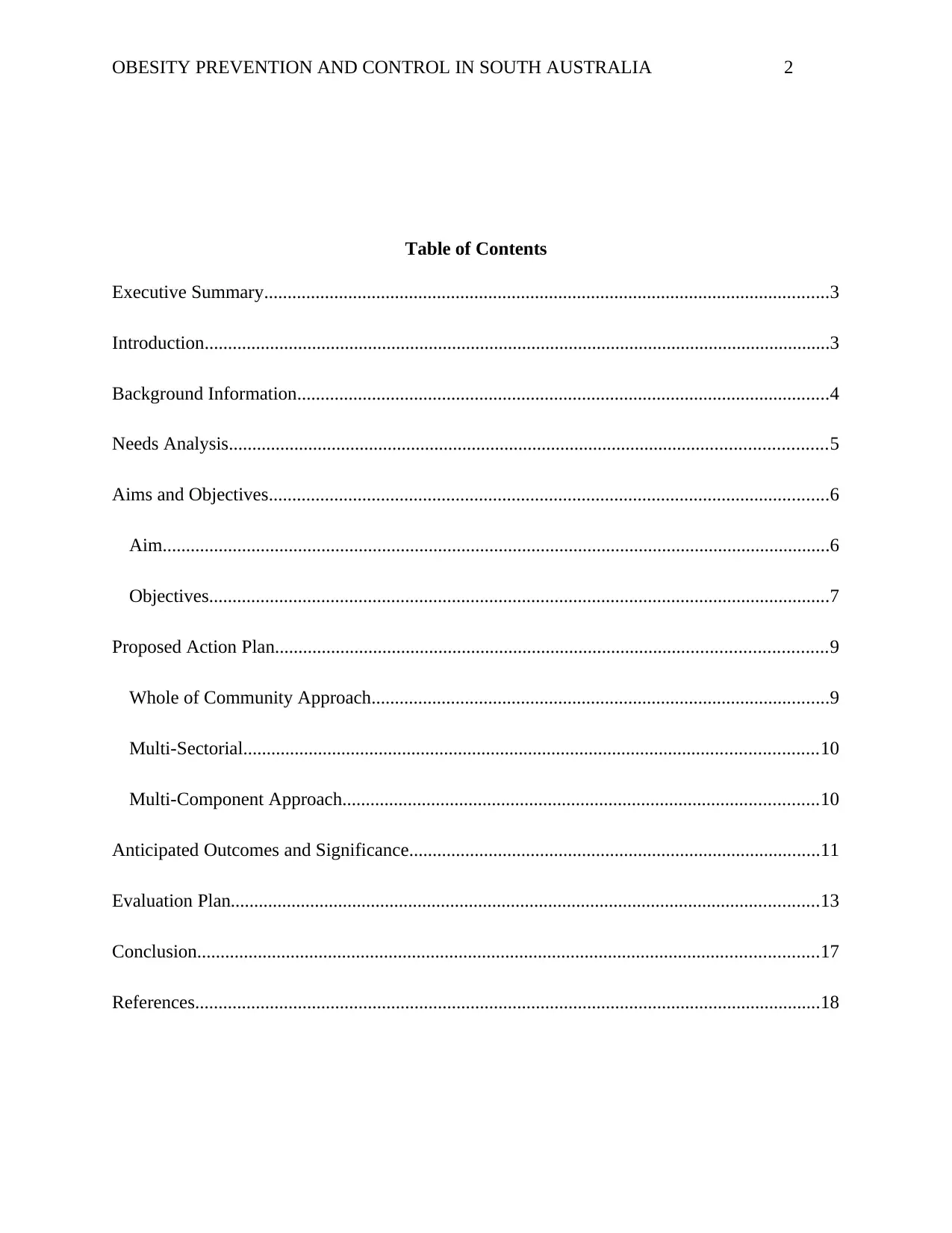
OBESITY PREVENTION AND CONTROL IN SOUTH AUSTRALIA 2
Table of Contents
Executive Summary.........................................................................................................................3
Introduction......................................................................................................................................3
Background Information..................................................................................................................4
Needs Analysis................................................................................................................................5
Aims and Objectives........................................................................................................................6
Aim...............................................................................................................................................6
Objectives.....................................................................................................................................7
Proposed Action Plan......................................................................................................................9
Whole of Community Approach..................................................................................................9
Multi-Sectorial...........................................................................................................................10
Multi-Component Approach......................................................................................................10
Anticipated Outcomes and Significance........................................................................................11
Evaluation Plan..............................................................................................................................13
Conclusion.....................................................................................................................................17
References......................................................................................................................................18
Table of Contents
Executive Summary.........................................................................................................................3
Introduction......................................................................................................................................3
Background Information..................................................................................................................4
Needs Analysis................................................................................................................................5
Aims and Objectives........................................................................................................................6
Aim...............................................................................................................................................6
Objectives.....................................................................................................................................7
Proposed Action Plan......................................................................................................................9
Whole of Community Approach..................................................................................................9
Multi-Sectorial...........................................................................................................................10
Multi-Component Approach......................................................................................................10
Anticipated Outcomes and Significance........................................................................................11
Evaluation Plan..............................................................................................................................13
Conclusion.....................................................................................................................................17
References......................................................................................................................................18
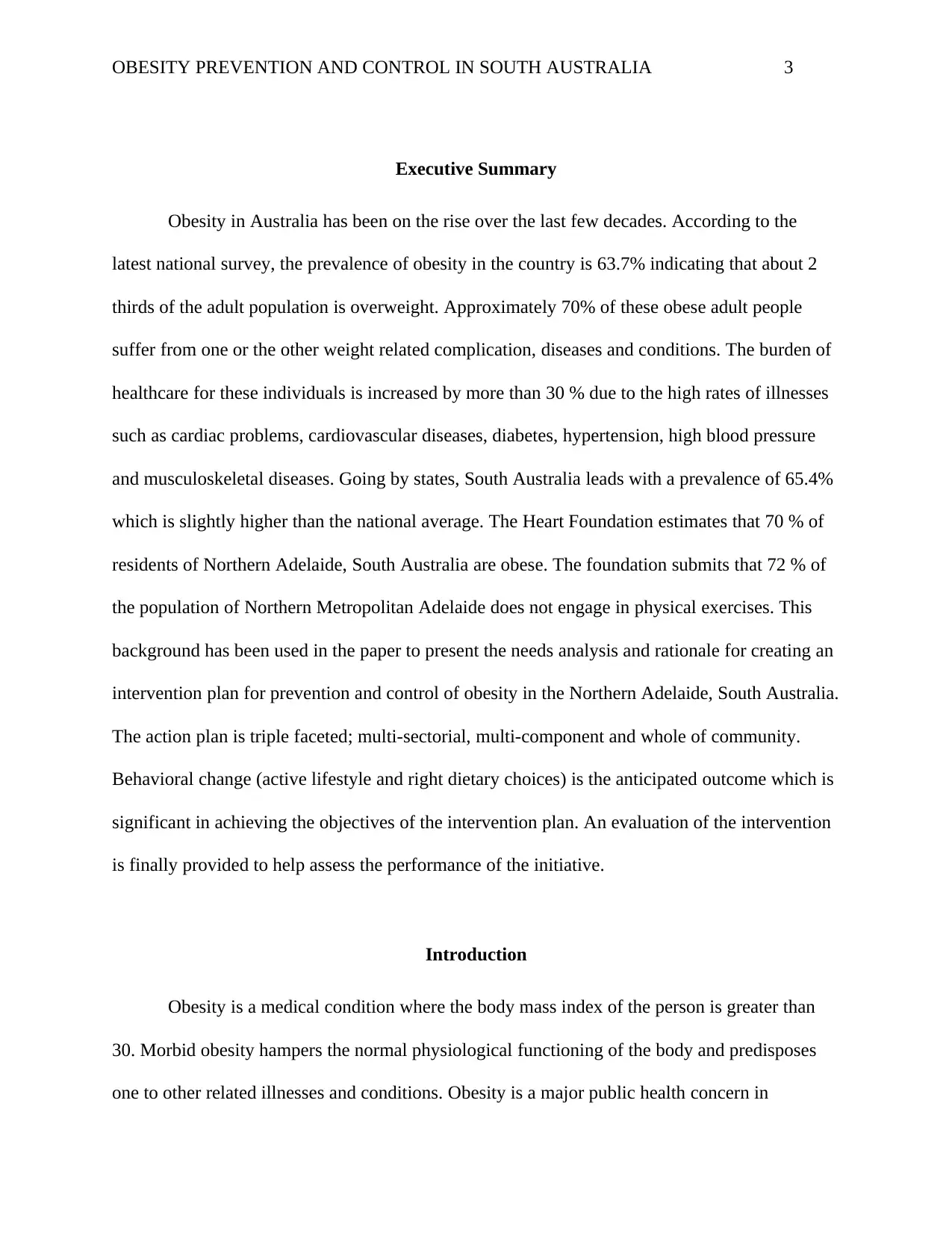
OBESITY PREVENTION AND CONTROL IN SOUTH AUSTRALIA 3
Executive Summary
Obesity in Australia has been on the rise over the last few decades. According to the
latest national survey, the prevalence of obesity in the country is 63.7% indicating that about 2
thirds of the adult population is overweight. Approximately 70% of these obese adult people
suffer from one or the other weight related complication, diseases and conditions. The burden of
healthcare for these individuals is increased by more than 30 % due to the high rates of illnesses
such as cardiac problems, cardiovascular diseases, diabetes, hypertension, high blood pressure
and musculoskeletal diseases. Going by states, South Australia leads with a prevalence of 65.4%
which is slightly higher than the national average. The Heart Foundation estimates that 70 % of
residents of Northern Adelaide, South Australia are obese. The foundation submits that 72 % of
the population of Northern Metropolitan Adelaide does not engage in physical exercises. This
background has been used in the paper to present the needs analysis and rationale for creating an
intervention plan for prevention and control of obesity in the Northern Adelaide, South Australia.
The action plan is triple faceted; multi-sectorial, multi-component and whole of community.
Behavioral change (active lifestyle and right dietary choices) is the anticipated outcome which is
significant in achieving the objectives of the intervention plan. An evaluation of the intervention
is finally provided to help assess the performance of the initiative.
Introduction
Obesity is a medical condition where the body mass index of the person is greater than
30. Morbid obesity hampers the normal physiological functioning of the body and predisposes
one to other related illnesses and conditions. Obesity is a major public health concern in
Executive Summary
Obesity in Australia has been on the rise over the last few decades. According to the
latest national survey, the prevalence of obesity in the country is 63.7% indicating that about 2
thirds of the adult population is overweight. Approximately 70% of these obese adult people
suffer from one or the other weight related complication, diseases and conditions. The burden of
healthcare for these individuals is increased by more than 30 % due to the high rates of illnesses
such as cardiac problems, cardiovascular diseases, diabetes, hypertension, high blood pressure
and musculoskeletal diseases. Going by states, South Australia leads with a prevalence of 65.4%
which is slightly higher than the national average. The Heart Foundation estimates that 70 % of
residents of Northern Adelaide, South Australia are obese. The foundation submits that 72 % of
the population of Northern Metropolitan Adelaide does not engage in physical exercises. This
background has been used in the paper to present the needs analysis and rationale for creating an
intervention plan for prevention and control of obesity in the Northern Adelaide, South Australia.
The action plan is triple faceted; multi-sectorial, multi-component and whole of community.
Behavioral change (active lifestyle and right dietary choices) is the anticipated outcome which is
significant in achieving the objectives of the intervention plan. An evaluation of the intervention
is finally provided to help assess the performance of the initiative.
Introduction
Obesity is a medical condition where the body mass index of the person is greater than
30. Morbid obesity hampers the normal physiological functioning of the body and predisposes
one to other related illnesses and conditions. Obesity is a major public health concern in
⊘ This is a preview!⊘
Do you want full access?
Subscribe today to unlock all pages.

Trusted by 1+ million students worldwide
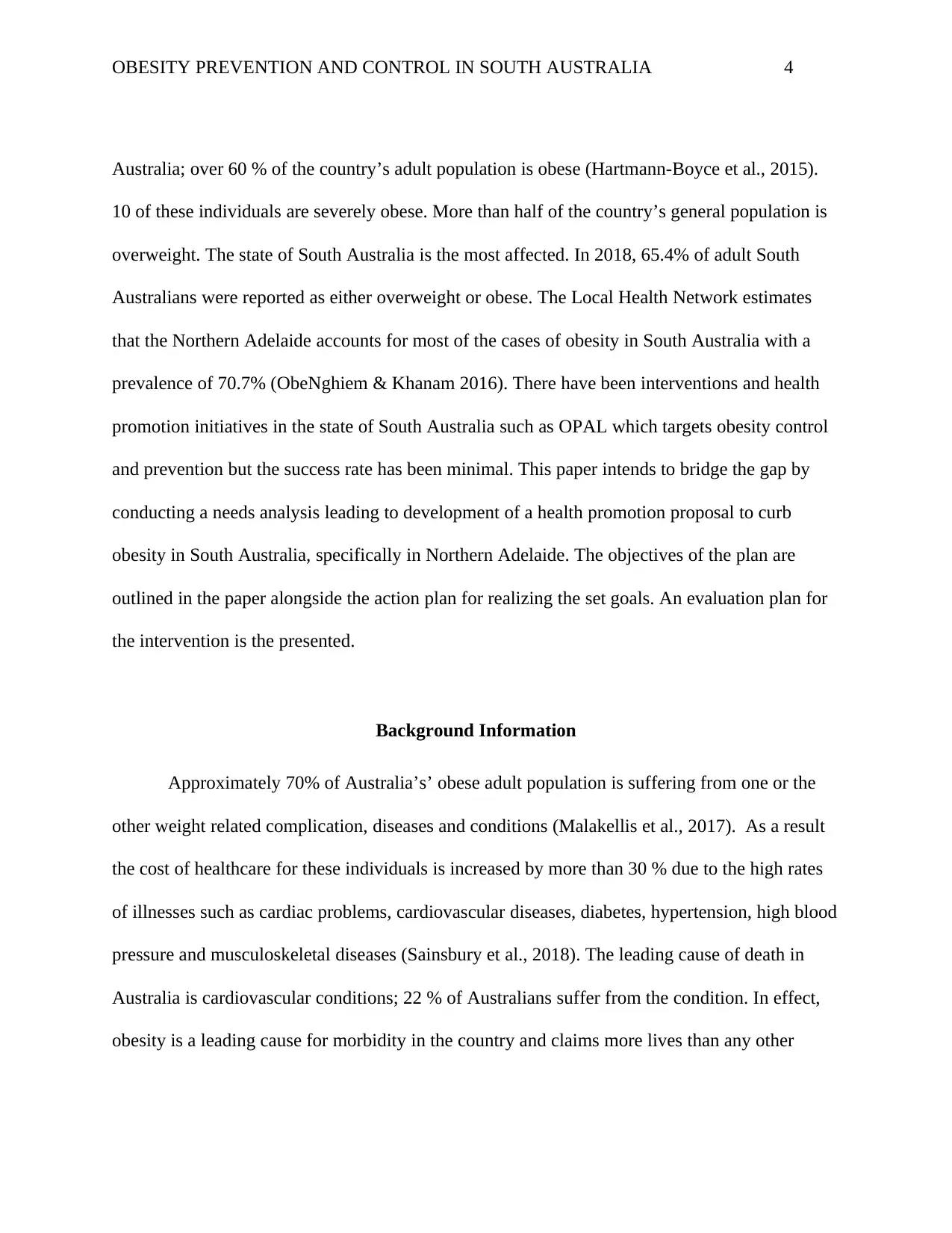
OBESITY PREVENTION AND CONTROL IN SOUTH AUSTRALIA 4
Australia; over 60 % of the country’s adult population is obese (Hartmann-Boyce et al., 2015).
10 of these individuals are severely obese. More than half of the country’s general population is
overweight. The state of South Australia is the most affected. In 2018, 65.4% of adult South
Australians were reported as either overweight or obese. The Local Health Network estimates
that the Northern Adelaide accounts for most of the cases of obesity in South Australia with a
prevalence of 70.7% (ObeNghiem & Khanam 2016). There have been interventions and health
promotion initiatives in the state of South Australia such as OPAL which targets obesity control
and prevention but the success rate has been minimal. This paper intends to bridge the gap by
conducting a needs analysis leading to development of a health promotion proposal to curb
obesity in South Australia, specifically in Northern Adelaide. The objectives of the plan are
outlined in the paper alongside the action plan for realizing the set goals. An evaluation plan for
the intervention is the presented.
Background Information
Approximately 70% of Australia’s’ obese adult population is suffering from one or the
other weight related complication, diseases and conditions (Malakellis et al., 2017). As a result
the cost of healthcare for these individuals is increased by more than 30 % due to the high rates
of illnesses such as cardiac problems, cardiovascular diseases, diabetes, hypertension, high blood
pressure and musculoskeletal diseases (Sainsbury et al., 2018). The leading cause of death in
Australia is cardiovascular conditions; 22 % of Australians suffer from the condition. In effect,
obesity is a leading cause for morbidity in the country and claims more lives than any other
Australia; over 60 % of the country’s adult population is obese (Hartmann-Boyce et al., 2015).
10 of these individuals are severely obese. More than half of the country’s general population is
overweight. The state of South Australia is the most affected. In 2018, 65.4% of adult South
Australians were reported as either overweight or obese. The Local Health Network estimates
that the Northern Adelaide accounts for most of the cases of obesity in South Australia with a
prevalence of 70.7% (ObeNghiem & Khanam 2016). There have been interventions and health
promotion initiatives in the state of South Australia such as OPAL which targets obesity control
and prevention but the success rate has been minimal. This paper intends to bridge the gap by
conducting a needs analysis leading to development of a health promotion proposal to curb
obesity in South Australia, specifically in Northern Adelaide. The objectives of the plan are
outlined in the paper alongside the action plan for realizing the set goals. An evaluation plan for
the intervention is the presented.
Background Information
Approximately 70% of Australia’s’ obese adult population is suffering from one or the
other weight related complication, diseases and conditions (Malakellis et al., 2017). As a result
the cost of healthcare for these individuals is increased by more than 30 % due to the high rates
of illnesses such as cardiac problems, cardiovascular diseases, diabetes, hypertension, high blood
pressure and musculoskeletal diseases (Sainsbury et al., 2018). The leading cause of death in
Australia is cardiovascular conditions; 22 % of Australians suffer from the condition. In effect,
obesity is a leading cause for morbidity in the country and claims more lives than any other
Paraphrase This Document
Need a fresh take? Get an instant paraphrase of this document with our AI Paraphraser
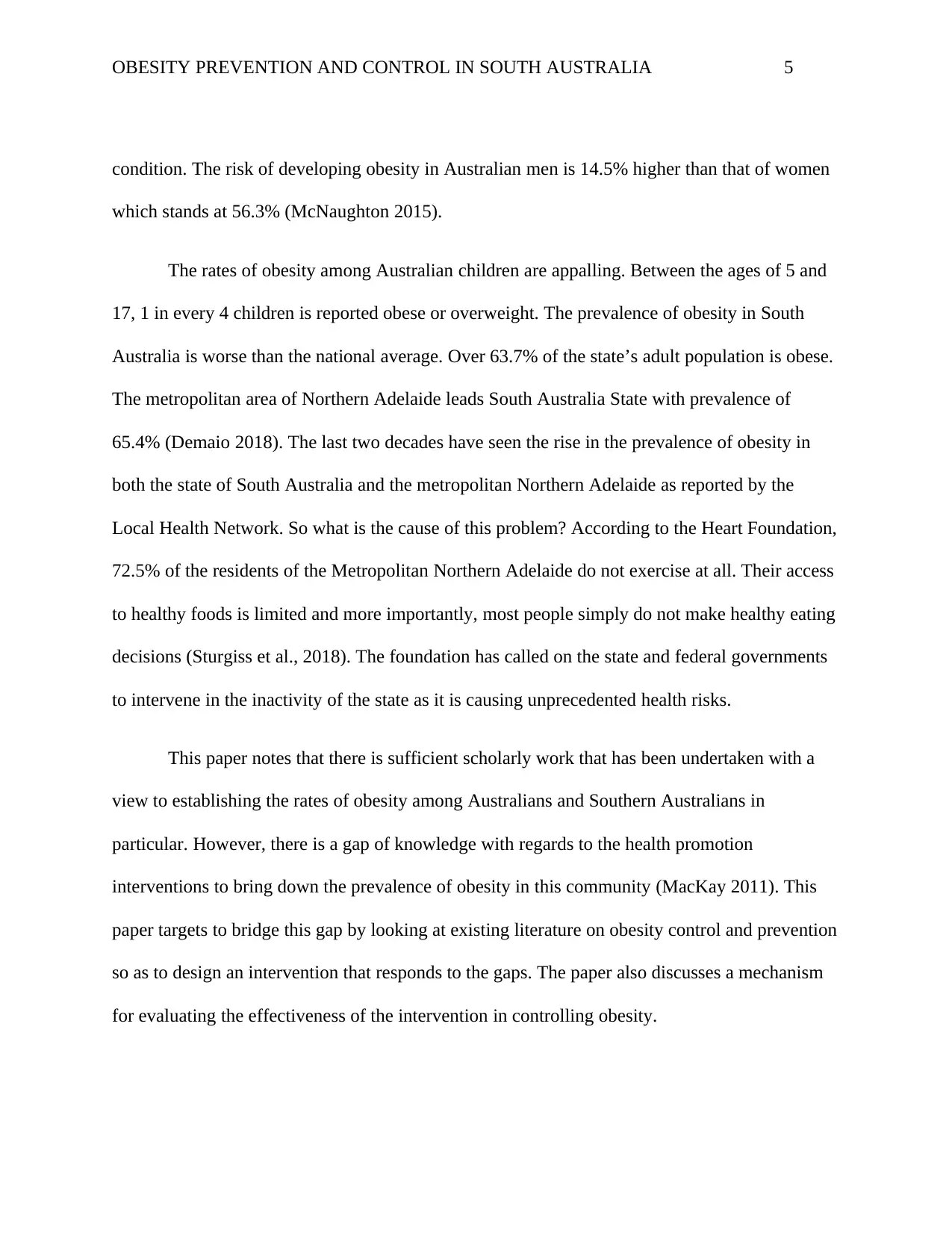
OBESITY PREVENTION AND CONTROL IN SOUTH AUSTRALIA 5
condition. The risk of developing obesity in Australian men is 14.5% higher than that of women
which stands at 56.3% (McNaughton 2015).
The rates of obesity among Australian children are appalling. Between the ages of 5 and
17, 1 in every 4 children is reported obese or overweight. The prevalence of obesity in South
Australia is worse than the national average. Over 63.7% of the state’s adult population is obese.
The metropolitan area of Northern Adelaide leads South Australia State with prevalence of
65.4% (Demaio 2018). The last two decades have seen the rise in the prevalence of obesity in
both the state of South Australia and the metropolitan Northern Adelaide as reported by the
Local Health Network. So what is the cause of this problem? According to the Heart Foundation,
72.5% of the residents of the Metropolitan Northern Adelaide do not exercise at all. Their access
to healthy foods is limited and more importantly, most people simply do not make healthy eating
decisions (Sturgiss et al., 2018). The foundation has called on the state and federal governments
to intervene in the inactivity of the state as it is causing unprecedented health risks.
This paper notes that there is sufficient scholarly work that has been undertaken with a
view to establishing the rates of obesity among Australians and Southern Australians in
particular. However, there is a gap of knowledge with regards to the health promotion
interventions to bring down the prevalence of obesity in this community (MacKay 2011). This
paper targets to bridge this gap by looking at existing literature on obesity control and prevention
so as to design an intervention that responds to the gaps. The paper also discusses a mechanism
for evaluating the effectiveness of the intervention in controlling obesity.
condition. The risk of developing obesity in Australian men is 14.5% higher than that of women
which stands at 56.3% (McNaughton 2015).
The rates of obesity among Australian children are appalling. Between the ages of 5 and
17, 1 in every 4 children is reported obese or overweight. The prevalence of obesity in South
Australia is worse than the national average. Over 63.7% of the state’s adult population is obese.
The metropolitan area of Northern Adelaide leads South Australia State with prevalence of
65.4% (Demaio 2018). The last two decades have seen the rise in the prevalence of obesity in
both the state of South Australia and the metropolitan Northern Adelaide as reported by the
Local Health Network. So what is the cause of this problem? According to the Heart Foundation,
72.5% of the residents of the Metropolitan Northern Adelaide do not exercise at all. Their access
to healthy foods is limited and more importantly, most people simply do not make healthy eating
decisions (Sturgiss et al., 2018). The foundation has called on the state and federal governments
to intervene in the inactivity of the state as it is causing unprecedented health risks.
This paper notes that there is sufficient scholarly work that has been undertaken with a
view to establishing the rates of obesity among Australians and Southern Australians in
particular. However, there is a gap of knowledge with regards to the health promotion
interventions to bring down the prevalence of obesity in this community (MacKay 2011). This
paper targets to bridge this gap by looking at existing literature on obesity control and prevention
so as to design an intervention that responds to the gaps. The paper also discusses a mechanism
for evaluating the effectiveness of the intervention in controlling obesity.
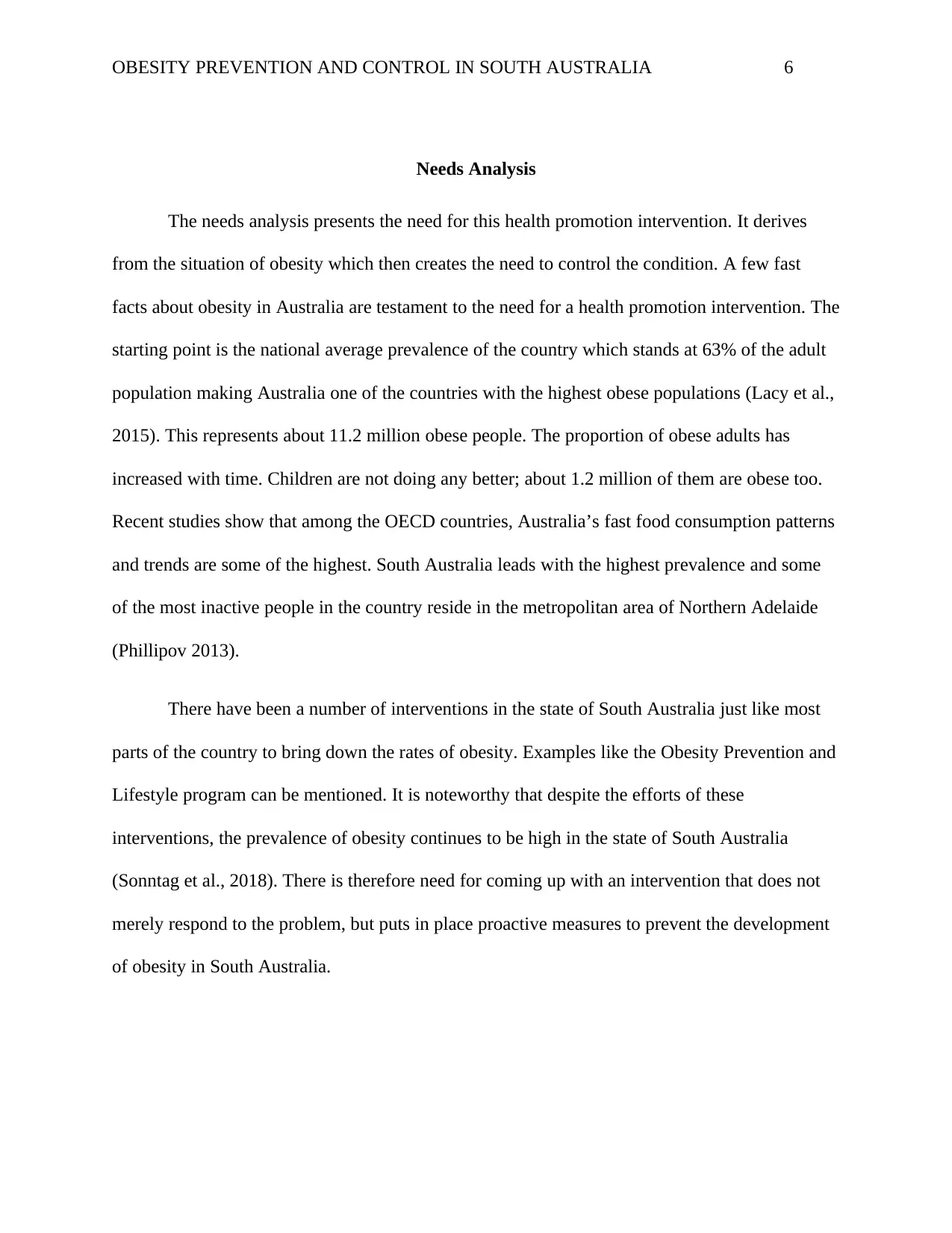
OBESITY PREVENTION AND CONTROL IN SOUTH AUSTRALIA 6
Needs Analysis
The needs analysis presents the need for this health promotion intervention. It derives
from the situation of obesity which then creates the need to control the condition. A few fast
facts about obesity in Australia are testament to the need for a health promotion intervention. The
starting point is the national average prevalence of the country which stands at 63% of the adult
population making Australia one of the countries with the highest obese populations (Lacy et al.,
2015). This represents about 11.2 million obese people. The proportion of obese adults has
increased with time. Children are not doing any better; about 1.2 million of them are obese too.
Recent studies show that among the OECD countries, Australia’s fast food consumption patterns
and trends are some of the highest. South Australia leads with the highest prevalence and some
of the most inactive people in the country reside in the metropolitan area of Northern Adelaide
(Phillipov 2013).
There have been a number of interventions in the state of South Australia just like most
parts of the country to bring down the rates of obesity. Examples like the Obesity Prevention and
Lifestyle program can be mentioned. It is noteworthy that despite the efforts of these
interventions, the prevalence of obesity continues to be high in the state of South Australia
(Sonntag et al., 2018). There is therefore need for coming up with an intervention that does not
merely respond to the problem, but puts in place proactive measures to prevent the development
of obesity in South Australia.
Needs Analysis
The needs analysis presents the need for this health promotion intervention. It derives
from the situation of obesity which then creates the need to control the condition. A few fast
facts about obesity in Australia are testament to the need for a health promotion intervention. The
starting point is the national average prevalence of the country which stands at 63% of the adult
population making Australia one of the countries with the highest obese populations (Lacy et al.,
2015). This represents about 11.2 million obese people. The proportion of obese adults has
increased with time. Children are not doing any better; about 1.2 million of them are obese too.
Recent studies show that among the OECD countries, Australia’s fast food consumption patterns
and trends are some of the highest. South Australia leads with the highest prevalence and some
of the most inactive people in the country reside in the metropolitan area of Northern Adelaide
(Phillipov 2013).
There have been a number of interventions in the state of South Australia just like most
parts of the country to bring down the rates of obesity. Examples like the Obesity Prevention and
Lifestyle program can be mentioned. It is noteworthy that despite the efforts of these
interventions, the prevalence of obesity continues to be high in the state of South Australia
(Sonntag et al., 2018). There is therefore need for coming up with an intervention that does not
merely respond to the problem, but puts in place proactive measures to prevent the development
of obesity in South Australia.
⊘ This is a preview!⊘
Do you want full access?
Subscribe today to unlock all pages.

Trusted by 1+ million students worldwide
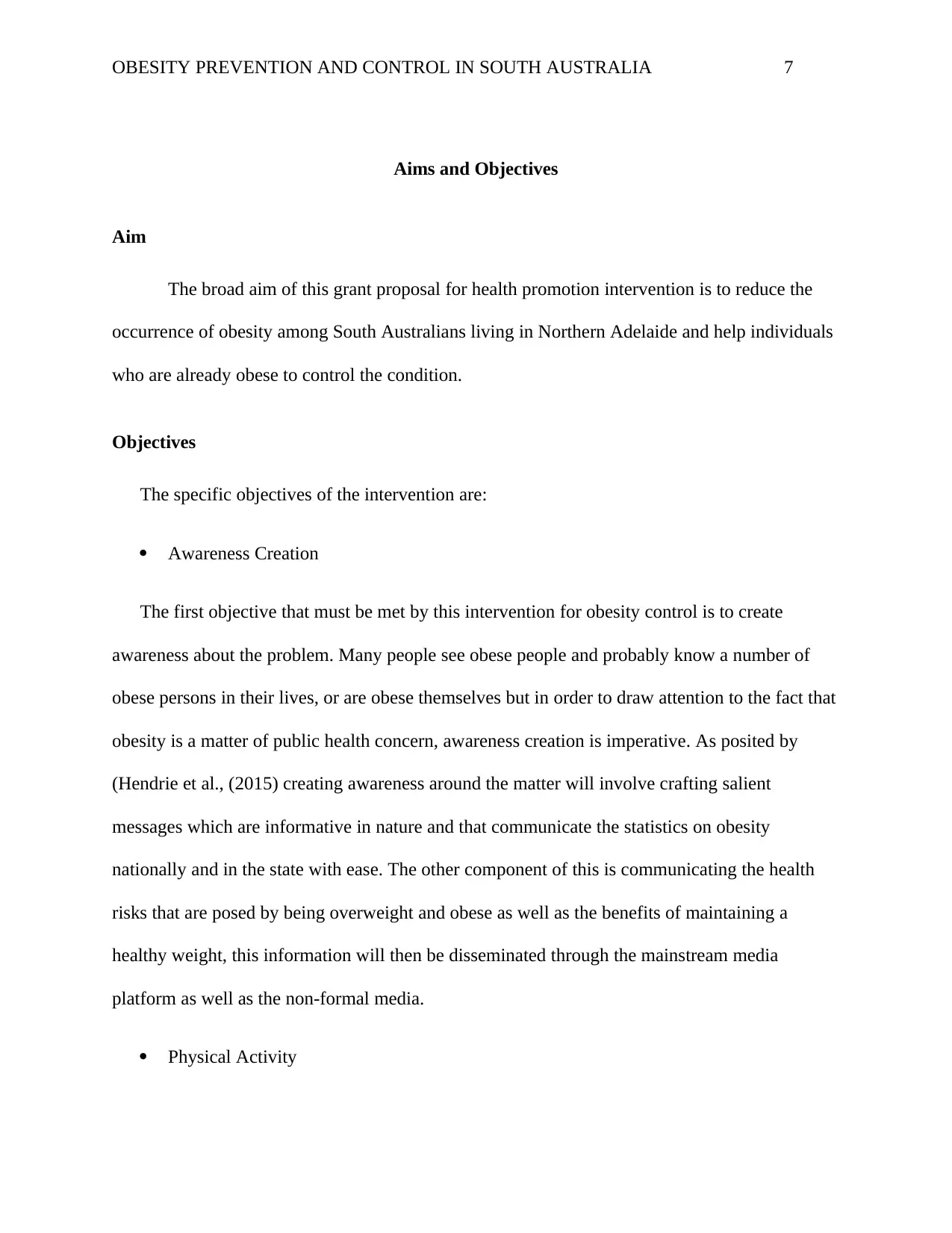
OBESITY PREVENTION AND CONTROL IN SOUTH AUSTRALIA 7
Aims and Objectives
Aim
The broad aim of this grant proposal for health promotion intervention is to reduce the
occurrence of obesity among South Australians living in Northern Adelaide and help individuals
who are already obese to control the condition.
Objectives
The specific objectives of the intervention are:
Awareness Creation
The first objective that must be met by this intervention for obesity control is to create
awareness about the problem. Many people see obese people and probably know a number of
obese persons in their lives, or are obese themselves but in order to draw attention to the fact that
obesity is a matter of public health concern, awareness creation is imperative. As posited by
(Hendrie et al., (2015) creating awareness around the matter will involve crafting salient
messages which are informative in nature and that communicate the statistics on obesity
nationally and in the state with ease. The other component of this is communicating the health
risks that are posed by being overweight and obese as well as the benefits of maintaining a
healthy weight, this information will then be disseminated through the mainstream media
platform as well as the non-formal media.
Physical Activity
Aims and Objectives
Aim
The broad aim of this grant proposal for health promotion intervention is to reduce the
occurrence of obesity among South Australians living in Northern Adelaide and help individuals
who are already obese to control the condition.
Objectives
The specific objectives of the intervention are:
Awareness Creation
The first objective that must be met by this intervention for obesity control is to create
awareness about the problem. Many people see obese people and probably know a number of
obese persons in their lives, or are obese themselves but in order to draw attention to the fact that
obesity is a matter of public health concern, awareness creation is imperative. As posited by
(Hendrie et al., (2015) creating awareness around the matter will involve crafting salient
messages which are informative in nature and that communicate the statistics on obesity
nationally and in the state with ease. The other component of this is communicating the health
risks that are posed by being overweight and obese as well as the benefits of maintaining a
healthy weight, this information will then be disseminated through the mainstream media
platform as well as the non-formal media.
Physical Activity
Paraphrase This Document
Need a fresh take? Get an instant paraphrase of this document with our AI Paraphraser
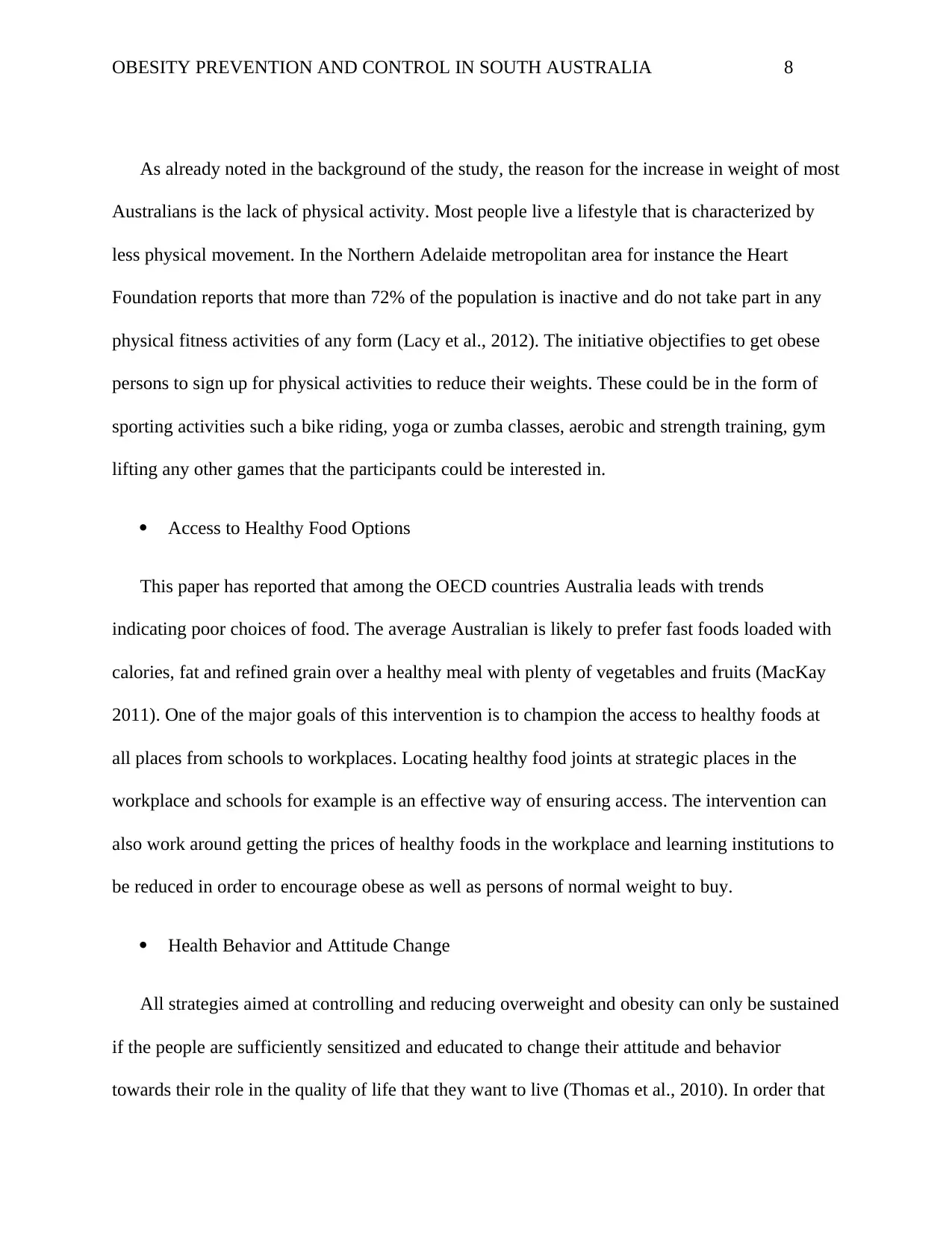
OBESITY PREVENTION AND CONTROL IN SOUTH AUSTRALIA 8
As already noted in the background of the study, the reason for the increase in weight of most
Australians is the lack of physical activity. Most people live a lifestyle that is characterized by
less physical movement. In the Northern Adelaide metropolitan area for instance the Heart
Foundation reports that more than 72% of the population is inactive and do not take part in any
physical fitness activities of any form (Lacy et al., 2012). The initiative objectifies to get obese
persons to sign up for physical activities to reduce their weights. These could be in the form of
sporting activities such a bike riding, yoga or zumba classes, aerobic and strength training, gym
lifting any other games that the participants could be interested in.
Access to Healthy Food Options
This paper has reported that among the OECD countries Australia leads with trends
indicating poor choices of food. The average Australian is likely to prefer fast foods loaded with
calories, fat and refined grain over a healthy meal with plenty of vegetables and fruits (MacKay
2011). One of the major goals of this intervention is to champion the access to healthy foods at
all places from schools to workplaces. Locating healthy food joints at strategic places in the
workplace and schools for example is an effective way of ensuring access. The intervention can
also work around getting the prices of healthy foods in the workplace and learning institutions to
be reduced in order to encourage obese as well as persons of normal weight to buy.
Health Behavior and Attitude Change
All strategies aimed at controlling and reducing overweight and obesity can only be sustained
if the people are sufficiently sensitized and educated to change their attitude and behavior
towards their role in the quality of life that they want to live (Thomas et al., 2010). In order that
As already noted in the background of the study, the reason for the increase in weight of most
Australians is the lack of physical activity. Most people live a lifestyle that is characterized by
less physical movement. In the Northern Adelaide metropolitan area for instance the Heart
Foundation reports that more than 72% of the population is inactive and do not take part in any
physical fitness activities of any form (Lacy et al., 2012). The initiative objectifies to get obese
persons to sign up for physical activities to reduce their weights. These could be in the form of
sporting activities such a bike riding, yoga or zumba classes, aerobic and strength training, gym
lifting any other games that the participants could be interested in.
Access to Healthy Food Options
This paper has reported that among the OECD countries Australia leads with trends
indicating poor choices of food. The average Australian is likely to prefer fast foods loaded with
calories, fat and refined grain over a healthy meal with plenty of vegetables and fruits (MacKay
2011). One of the major goals of this intervention is to champion the access to healthy foods at
all places from schools to workplaces. Locating healthy food joints at strategic places in the
workplace and schools for example is an effective way of ensuring access. The intervention can
also work around getting the prices of healthy foods in the workplace and learning institutions to
be reduced in order to encourage obese as well as persons of normal weight to buy.
Health Behavior and Attitude Change
All strategies aimed at controlling and reducing overweight and obesity can only be sustained
if the people are sufficiently sensitized and educated to change their attitude and behavior
towards their role in the quality of life that they want to live (Thomas et al., 2010). In order that
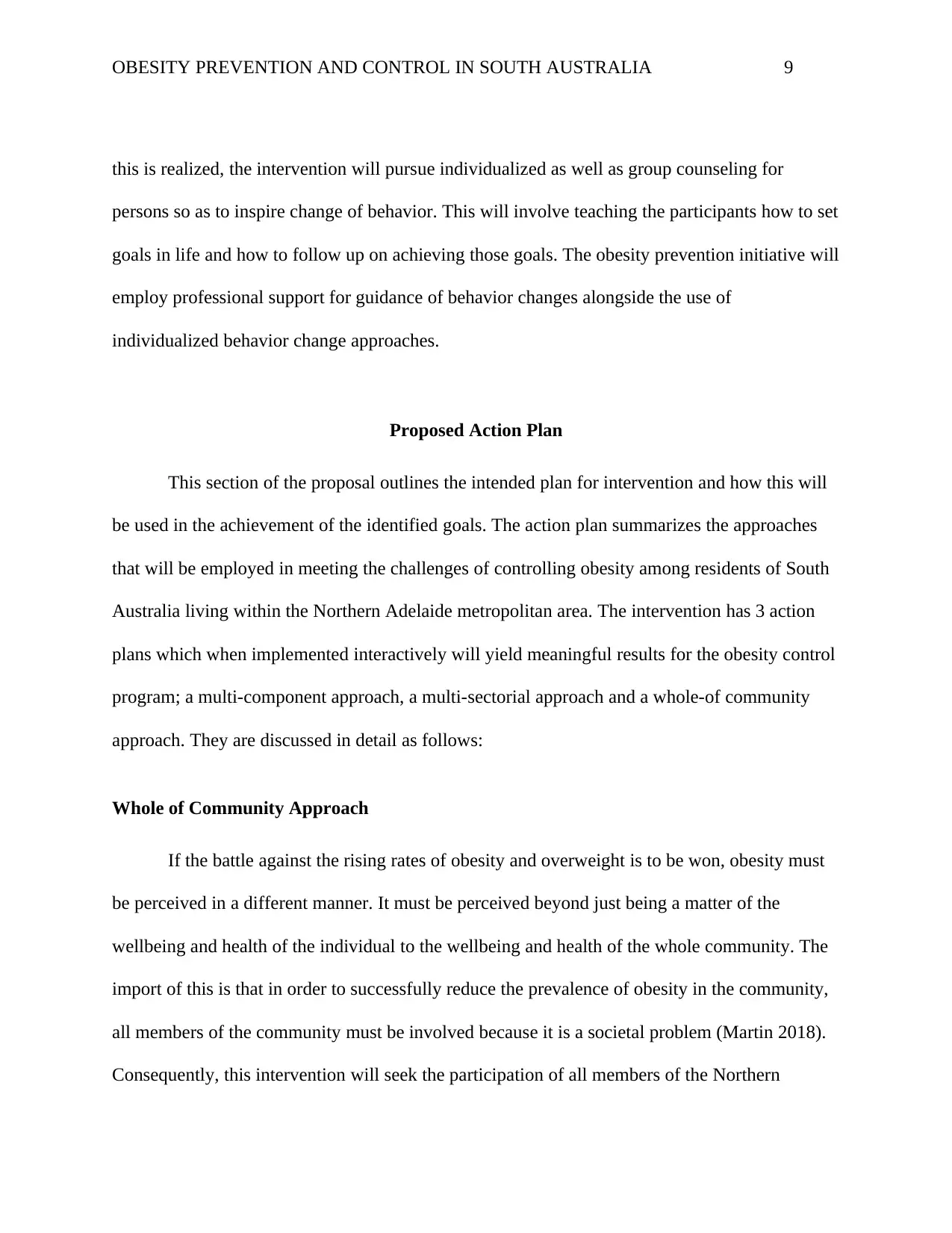
OBESITY PREVENTION AND CONTROL IN SOUTH AUSTRALIA 9
this is realized, the intervention will pursue individualized as well as group counseling for
persons so as to inspire change of behavior. This will involve teaching the participants how to set
goals in life and how to follow up on achieving those goals. The obesity prevention initiative will
employ professional support for guidance of behavior changes alongside the use of
individualized behavior change approaches.
Proposed Action Plan
This section of the proposal outlines the intended plan for intervention and how this will
be used in the achievement of the identified goals. The action plan summarizes the approaches
that will be employed in meeting the challenges of controlling obesity among residents of South
Australia living within the Northern Adelaide metropolitan area. The intervention has 3 action
plans which when implemented interactively will yield meaningful results for the obesity control
program; a multi-component approach, a multi-sectorial approach and a whole-of community
approach. They are discussed in detail as follows:
Whole of Community Approach
If the battle against the rising rates of obesity and overweight is to be won, obesity must
be perceived in a different manner. It must be perceived beyond just being a matter of the
wellbeing and health of the individual to the wellbeing and health of the whole community. The
import of this is that in order to successfully reduce the prevalence of obesity in the community,
all members of the community must be involved because it is a societal problem (Martin 2018).
Consequently, this intervention will seek the participation of all members of the Northern
this is realized, the intervention will pursue individualized as well as group counseling for
persons so as to inspire change of behavior. This will involve teaching the participants how to set
goals in life and how to follow up on achieving those goals. The obesity prevention initiative will
employ professional support for guidance of behavior changes alongside the use of
individualized behavior change approaches.
Proposed Action Plan
This section of the proposal outlines the intended plan for intervention and how this will
be used in the achievement of the identified goals. The action plan summarizes the approaches
that will be employed in meeting the challenges of controlling obesity among residents of South
Australia living within the Northern Adelaide metropolitan area. The intervention has 3 action
plans which when implemented interactively will yield meaningful results for the obesity control
program; a multi-component approach, a multi-sectorial approach and a whole-of community
approach. They are discussed in detail as follows:
Whole of Community Approach
If the battle against the rising rates of obesity and overweight is to be won, obesity must
be perceived in a different manner. It must be perceived beyond just being a matter of the
wellbeing and health of the individual to the wellbeing and health of the whole community. The
import of this is that in order to successfully reduce the prevalence of obesity in the community,
all members of the community must be involved because it is a societal problem (Martin 2018).
Consequently, this intervention will seek the participation of all members of the Northern
⊘ This is a preview!⊘
Do you want full access?
Subscribe today to unlock all pages.

Trusted by 1+ million students worldwide
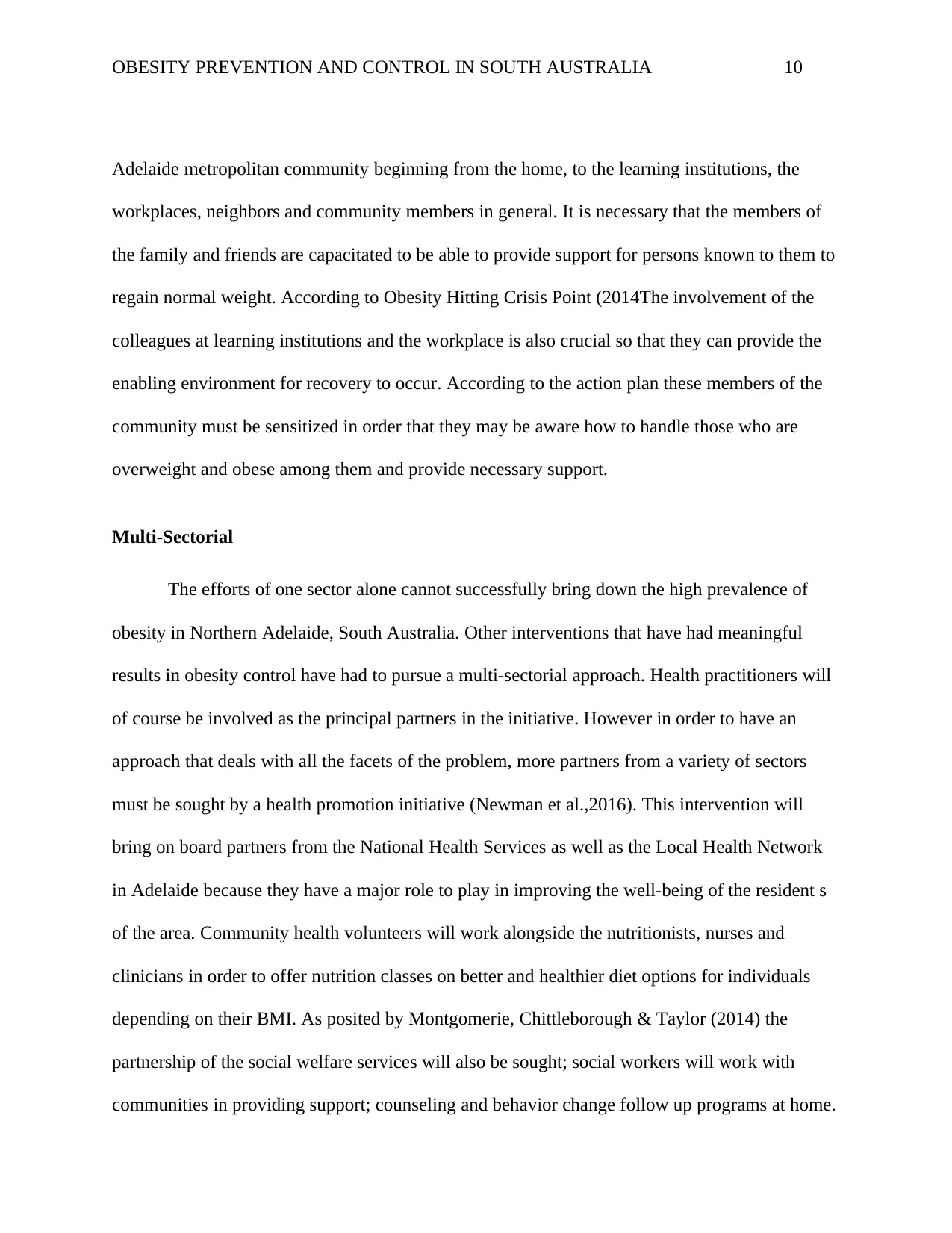
OBESITY PREVENTION AND CONTROL IN SOUTH AUSTRALIA 10
Adelaide metropolitan community beginning from the home, to the learning institutions, the
workplaces, neighbors and community members in general. It is necessary that the members of
the family and friends are capacitated to be able to provide support for persons known to them to
regain normal weight. According to Obesity Hitting Crisis Point (2014The involvement of the
colleagues at learning institutions and the workplace is also crucial so that they can provide the
enabling environment for recovery to occur. According to the action plan these members of the
community must be sensitized in order that they may be aware how to handle those who are
overweight and obese among them and provide necessary support.
Multi-Sectorial
The efforts of one sector alone cannot successfully bring down the high prevalence of
obesity in Northern Adelaide, South Australia. Other interventions that have had meaningful
results in obesity control have had to pursue a multi-sectorial approach. Health practitioners will
of course be involved as the principal partners in the initiative. However in order to have an
approach that deals with all the facets of the problem, more partners from a variety of sectors
must be sought by a health promotion initiative (Newman et al.,2016). This intervention will
bring on board partners from the National Health Services as well as the Local Health Network
in Adelaide because they have a major role to play in improving the well-being of the resident s
of the area. Community health volunteers will work alongside the nutritionists, nurses and
clinicians in order to offer nutrition classes on better and healthier diet options for individuals
depending on their BMI. As posited by Montgomerie, Chittleborough & Taylor (2014) the
partnership of the social welfare services will also be sought; social workers will work with
communities in providing support; counseling and behavior change follow up programs at home.
Adelaide metropolitan community beginning from the home, to the learning institutions, the
workplaces, neighbors and community members in general. It is necessary that the members of
the family and friends are capacitated to be able to provide support for persons known to them to
regain normal weight. According to Obesity Hitting Crisis Point (2014The involvement of the
colleagues at learning institutions and the workplace is also crucial so that they can provide the
enabling environment for recovery to occur. According to the action plan these members of the
community must be sensitized in order that they may be aware how to handle those who are
overweight and obese among them and provide necessary support.
Multi-Sectorial
The efforts of one sector alone cannot successfully bring down the high prevalence of
obesity in Northern Adelaide, South Australia. Other interventions that have had meaningful
results in obesity control have had to pursue a multi-sectorial approach. Health practitioners will
of course be involved as the principal partners in the initiative. However in order to have an
approach that deals with all the facets of the problem, more partners from a variety of sectors
must be sought by a health promotion initiative (Newman et al.,2016). This intervention will
bring on board partners from the National Health Services as well as the Local Health Network
in Adelaide because they have a major role to play in improving the well-being of the resident s
of the area. Community health volunteers will work alongside the nutritionists, nurses and
clinicians in order to offer nutrition classes on better and healthier diet options for individuals
depending on their BMI. As posited by Montgomerie, Chittleborough & Taylor (2014) the
partnership of the social welfare services will also be sought; social workers will work with
communities in providing support; counseling and behavior change follow up programs at home.
Paraphrase This Document
Need a fresh take? Get an instant paraphrase of this document with our AI Paraphraser
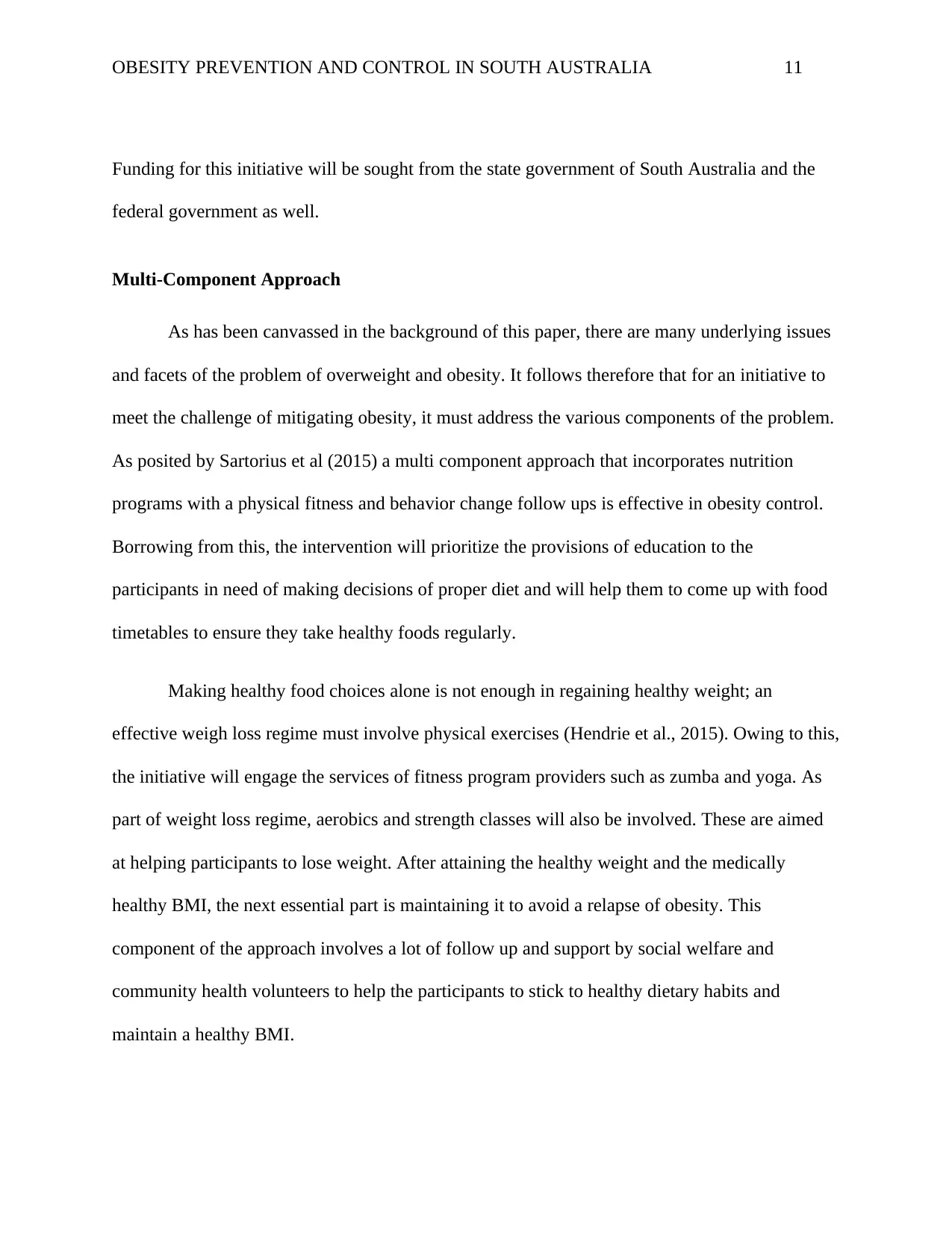
OBESITY PREVENTION AND CONTROL IN SOUTH AUSTRALIA 11
Funding for this initiative will be sought from the state government of South Australia and the
federal government as well.
Multi-Component Approach
As has been canvassed in the background of this paper, there are many underlying issues
and facets of the problem of overweight and obesity. It follows therefore that for an initiative to
meet the challenge of mitigating obesity, it must address the various components of the problem.
As posited by Sartorius et al (2015) a multi component approach that incorporates nutrition
programs with a physical fitness and behavior change follow ups is effective in obesity control.
Borrowing from this, the intervention will prioritize the provisions of education to the
participants in need of making decisions of proper diet and will help them to come up with food
timetables to ensure they take healthy foods regularly.
Making healthy food choices alone is not enough in regaining healthy weight; an
effective weigh loss regime must involve physical exercises (Hendrie et al., 2015). Owing to this,
the initiative will engage the services of fitness program providers such as zumba and yoga. As
part of weight loss regime, aerobics and strength classes will also be involved. These are aimed
at helping participants to lose weight. After attaining the healthy weight and the medically
healthy BMI, the next essential part is maintaining it to avoid a relapse of obesity. This
component of the approach involves a lot of follow up and support by social welfare and
community health volunteers to help the participants to stick to healthy dietary habits and
maintain a healthy BMI.
Funding for this initiative will be sought from the state government of South Australia and the
federal government as well.
Multi-Component Approach
As has been canvassed in the background of this paper, there are many underlying issues
and facets of the problem of overweight and obesity. It follows therefore that for an initiative to
meet the challenge of mitigating obesity, it must address the various components of the problem.
As posited by Sartorius et al (2015) a multi component approach that incorporates nutrition
programs with a physical fitness and behavior change follow ups is effective in obesity control.
Borrowing from this, the intervention will prioritize the provisions of education to the
participants in need of making decisions of proper diet and will help them to come up with food
timetables to ensure they take healthy foods regularly.
Making healthy food choices alone is not enough in regaining healthy weight; an
effective weigh loss regime must involve physical exercises (Hendrie et al., 2015). Owing to this,
the initiative will engage the services of fitness program providers such as zumba and yoga. As
part of weight loss regime, aerobics and strength classes will also be involved. These are aimed
at helping participants to lose weight. After attaining the healthy weight and the medically
healthy BMI, the next essential part is maintaining it to avoid a relapse of obesity. This
component of the approach involves a lot of follow up and support by social welfare and
community health volunteers to help the participants to stick to healthy dietary habits and
maintain a healthy BMI.
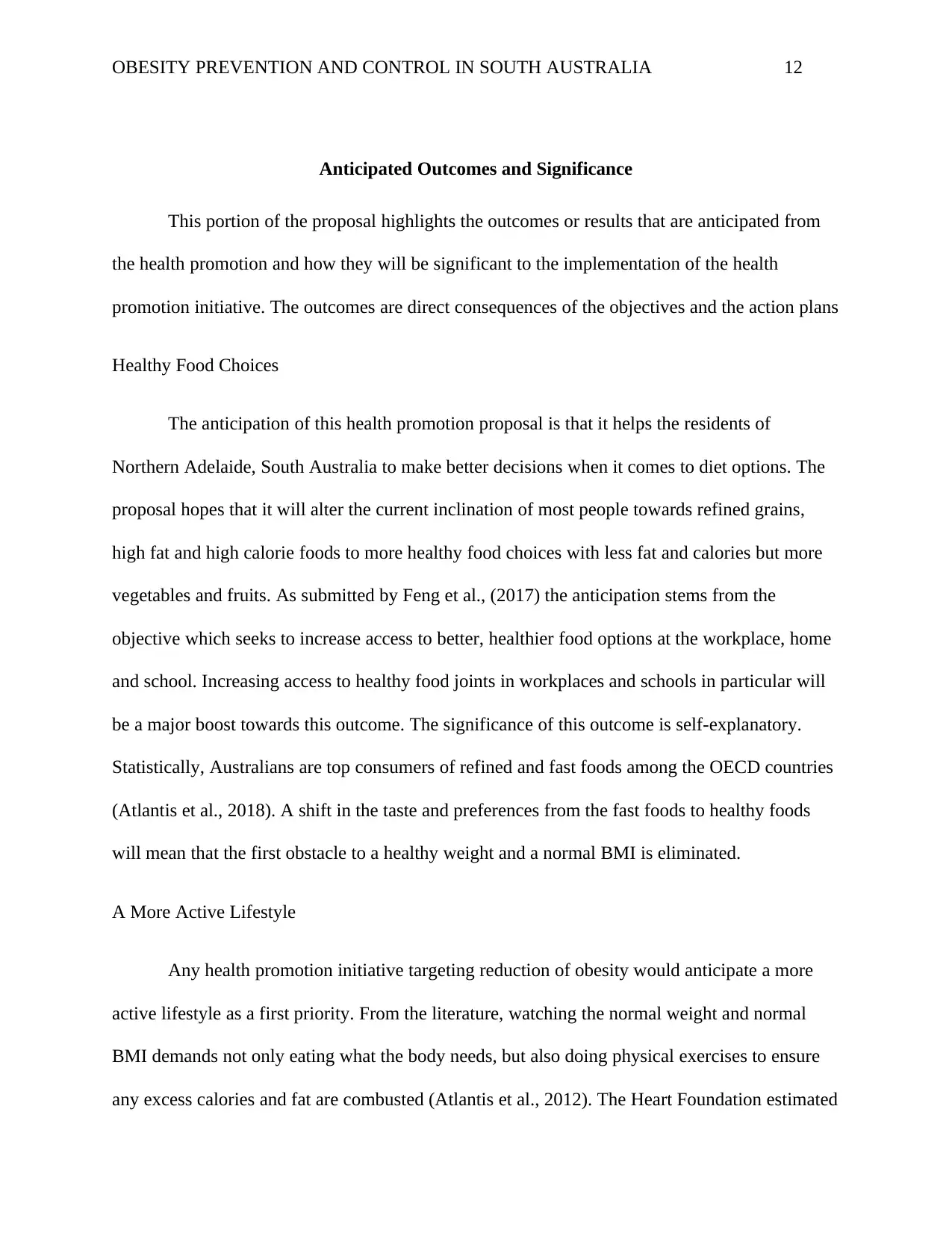
OBESITY PREVENTION AND CONTROL IN SOUTH AUSTRALIA 12
Anticipated Outcomes and Significance
This portion of the proposal highlights the outcomes or results that are anticipated from
the health promotion and how they will be significant to the implementation of the health
promotion initiative. The outcomes are direct consequences of the objectives and the action plans
Healthy Food Choices
The anticipation of this health promotion proposal is that it helps the residents of
Northern Adelaide, South Australia to make better decisions when it comes to diet options. The
proposal hopes that it will alter the current inclination of most people towards refined grains,
high fat and high calorie foods to more healthy food choices with less fat and calories but more
vegetables and fruits. As submitted by Feng et al., (2017) the anticipation stems from the
objective which seeks to increase access to better, healthier food options at the workplace, home
and school. Increasing access to healthy food joints in workplaces and schools in particular will
be a major boost towards this outcome. The significance of this outcome is self-explanatory.
Statistically, Australians are top consumers of refined and fast foods among the OECD countries
(Atlantis et al., 2018). A shift in the taste and preferences from the fast foods to healthy foods
will mean that the first obstacle to a healthy weight and a normal BMI is eliminated.
A More Active Lifestyle
Any health promotion initiative targeting reduction of obesity would anticipate a more
active lifestyle as a first priority. From the literature, watching the normal weight and normal
BMI demands not only eating what the body needs, but also doing physical exercises to ensure
any excess calories and fat are combusted (Atlantis et al., 2012). The Heart Foundation estimated
Anticipated Outcomes and Significance
This portion of the proposal highlights the outcomes or results that are anticipated from
the health promotion and how they will be significant to the implementation of the health
promotion initiative. The outcomes are direct consequences of the objectives and the action plans
Healthy Food Choices
The anticipation of this health promotion proposal is that it helps the residents of
Northern Adelaide, South Australia to make better decisions when it comes to diet options. The
proposal hopes that it will alter the current inclination of most people towards refined grains,
high fat and high calorie foods to more healthy food choices with less fat and calories but more
vegetables and fruits. As submitted by Feng et al., (2017) the anticipation stems from the
objective which seeks to increase access to better, healthier food options at the workplace, home
and school. Increasing access to healthy food joints in workplaces and schools in particular will
be a major boost towards this outcome. The significance of this outcome is self-explanatory.
Statistically, Australians are top consumers of refined and fast foods among the OECD countries
(Atlantis et al., 2018). A shift in the taste and preferences from the fast foods to healthy foods
will mean that the first obstacle to a healthy weight and a normal BMI is eliminated.
A More Active Lifestyle
Any health promotion initiative targeting reduction of obesity would anticipate a more
active lifestyle as a first priority. From the literature, watching the normal weight and normal
BMI demands not only eating what the body needs, but also doing physical exercises to ensure
any excess calories and fat are combusted (Atlantis et al., 2012). The Heart Foundation estimated
⊘ This is a preview!⊘
Do you want full access?
Subscribe today to unlock all pages.

Trusted by 1+ million students worldwide
1 out of 26
Related Documents
Your All-in-One AI-Powered Toolkit for Academic Success.
+13062052269
info@desklib.com
Available 24*7 on WhatsApp / Email
![[object Object]](/_next/static/media/star-bottom.7253800d.svg)
Unlock your academic potential
Copyright © 2020–2025 A2Z Services. All Rights Reserved. Developed and managed by ZUCOL.





